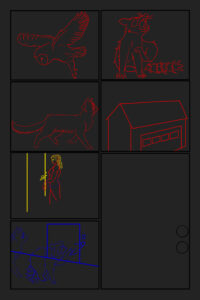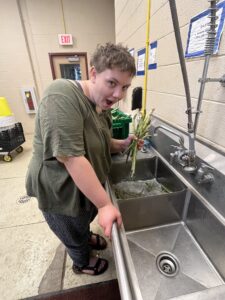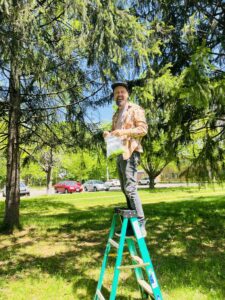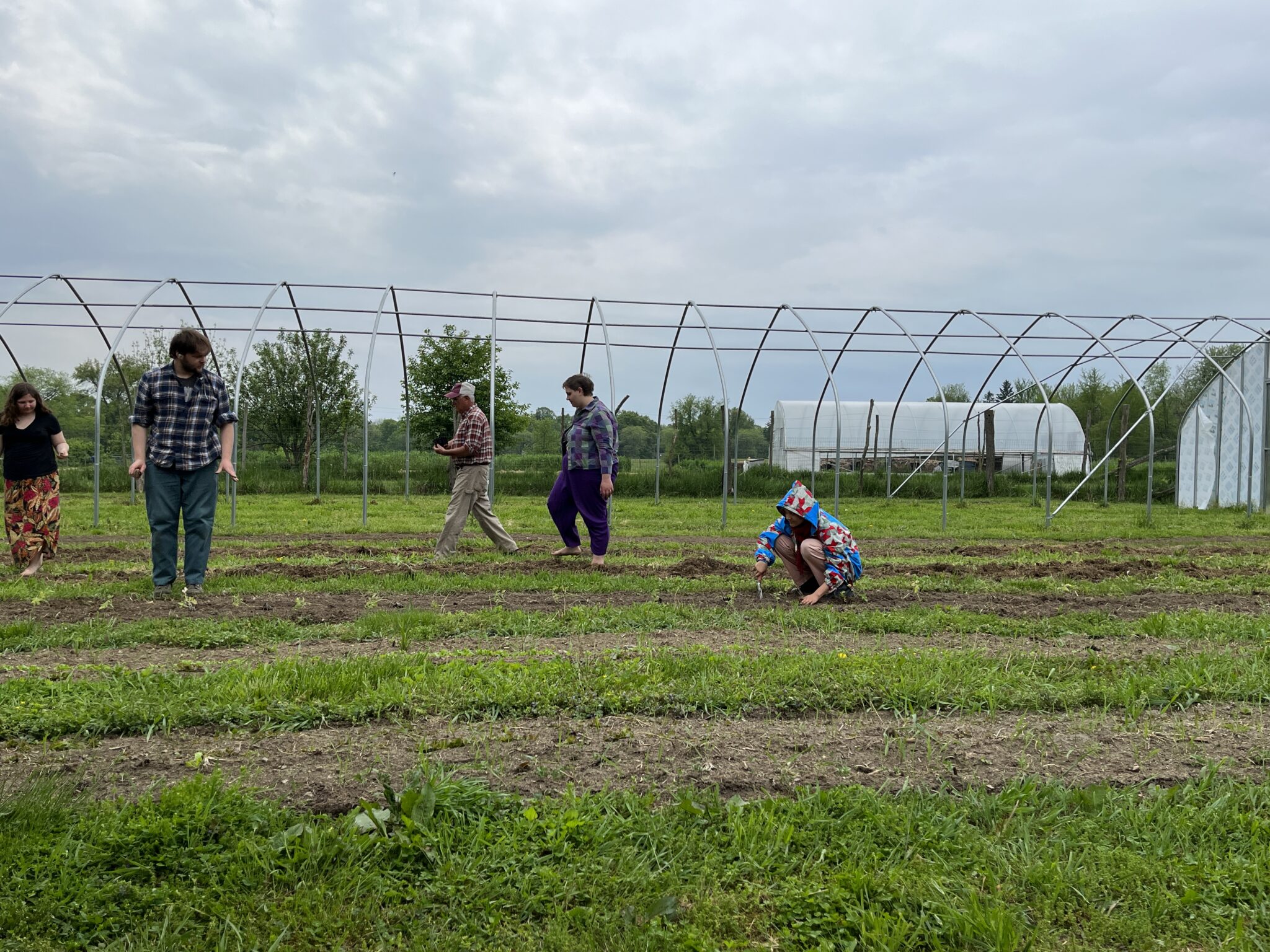Farm-to-Table lead produce processor: Yuri Whitley 26′ at Antioch College Farm and Kitchens
Sep 26, 2024I typically kick off my week by heading to the kitchen for breakfast and then checking the farm cooler to assess what needs to be processed. Lately, we’ve been dealing with an abundance of tomatoes and zucchinis, so most days involve cutting and storing these items in bags and cambrios. Afterward, we transport them to the freezer and pack it to capacity.
We’ve been focused on enhancing the efficiency of processing the produce from the farm and the truck. One of the challenges we encountered was the kitchen staff not having enough time to process the food and prepare meals for the students simultaneously, resulting in a lot of produce going to waste. To tackle this, Bruce, the farm manager, and Dawn, the kitchen manager, worked together to create a new position that prioritizes the farm-to-table process, elevating it to a leading role over the farm-to-table students. This has streamlined the identification of areas for improvement and improved communication between the farm and the kitchen. In addition, we’ve brought on two other part-time students who work on the farm and in the kitchen, helping us stay informed about farm activities and plan our meals accordingly.
Processing produce also involves making and preparing food for the chefs, which adds another dimension of coordination and communication between the farm and the kitchen.
Creating a Webcomic “Hidden in Plain Sight”: Yuri Whitley ‘26
Feb 21, 2024An average week of working on a page for the comic consists of many hours of planning and sketching out the page’s look before committing to a final design and starting it. The beginning of the week is going into my plan-out paper on Google Docs and writing down a rough draft of what I want the page to look like. This includes the character(s) making certain gestures or saying specific dialogue. As well as what is going on around the character(s) to help the viewer understand the emotion of the scene. The time frame that this takes can be anywhere from 5 minutes to a whole day. Even though it takes me a long time to choose what I want to be portrayed in each scene, I still end up changing pieces of the original plan.

For example, on Page 15 of the comic, I completely reworked the format of the page. The original plan was to have six panels instead of five. The first two would be the same, but the next two would have been about six times their size. This would have resulted in a lot of unneeded background space, so instead, I decided to just do a close-up of the original sketch so that you have an easier time understanding what the larger picture would have had a difficult time showing. The last two panels would have been a close-up of all of their legs walking out of the door; just separated into one was the person walking out, as they are in full body on the last panel, and the other two who were sleeping were rushing after them.

The next day starts with the sketchup of the page. This is where I start to design what the page is going to look like. Including the colors and the position of the “camera”. I will also sketch the full objects, even if another object of character is blocking part of them, so I can see if any of that needs to be adjusted. I have also learned that color-coding each different thing makes it easier to understand what is happening, so you don’t see parts of the sketch and get confused about what part goes to. The photo on the right is the complete sketchup of page 16.

The third day is usually used to get the line work done. Depending on the complexity of the background, that can bleed into day four. Page 17 on the left is a great example of that. That whole page took almost two whole days to finish. I knew going into the design that the first panel was going to take a very long time to finish, so I did the last two first. As for the pages that don’t take too long, day four is all about color.
Getting all of the base colors done so that the last day of the week can be on track. The fifth and final day of the week is lighting and speech bubbles. What is the light source? Is it the sun, the moon, or a desk light at night? Is it overhead, in front, behind, or under the person, people, or object(s)? What direction is the shadow going to be projected based on the angle? All of these questions and more are what I have to take into account when it comes to every panel. Even if you can barely see it, every single object and person has a shadow, which has to be taken into account when it comes to lighting.
I haven’t been alone in figuring out what exactly needs adjustment or help with colors when it comes to scenes. I have been getting lots of help from Sally Francis, a cartoon artist and animator. She has been a huge help during this time. She’s helped me with drawing out panels and coloring panels. She’s also given me lots of constructive criticism about pages and has helped me improve the pages and improve on what I was struggling with, as well as some pointers to things I hadn’t even thought about. Sally also mentioned that keeping the details in the foreground and midground will help keep the viewer’s gaze where you want it to go. And to keep simple shapes in the background.
I looked into this more, and it is supposed to make the viewer disinterested in what is happening outside of the dialogue you want them to focus on. When it came to bettering the color contrast between the background and the character(s) or Object that is meant to be the focus of the panel Warm colors are a natural eye-catcher. The brain makes it a priority to look for and focus on warm colors in an image. However, I am trying to find ways to put the focus on a character that wears lots of cool colors like blues, purples, and blacks. I am working on ways to add warm-colored accents to grab the eye of the viewer. Right now, I am stuck between making the jewelry. This character wears gold instead of silver to see if that helps the scene. I genuinely don’t think that the pages that I have been working on over my Co-Op would have ended up the way they did without all the help that she has given me so far in the term, and I can’t wait to look back on the improvements in the next five weeks and see how much has changed with getting help and learning from Sally. If you want to read the ongoing comic, you can check it out for free on Webtoon and Tapas.
Learning to return to the land: Yuri Whitley ‘26 at the Antioch Farm
Jun 15, 2023The Antioch farm is a small-scale farm that works to provide farm-to-table produce for our community. Our primary goal is to be able to have enough produce to feed all of the students and staff on campus continuously. Growing up in a small town surrounded by farmland it is amazing to see and be a part of the campus farm. I have met so many amazing people in just a few weeks. My working experience on the farm has taught me so much about sustainable farming, a subject I knew very little about before this co-op opportunity. Being able to be a part of all the hard work that goes into making the farm what it is today is so fulfilling and inspiring to me. I have come to realize that it’s not just people on campus who love the farm but it’s also the local citizens of Yellow Springs. Throughout each day I see and talk to so many citizens of Yellow Springs. Getting to know my neighbors as they take their morning walks by the farm is so fun and a high point in my day. There is always someone that wants to see what we’re doing or ask a question about the operation of the farm.

An average day on the farm for me is getting to the farm at 7 am and harvesting different vegetables, weighing them, and then washing them. After all that is done, we pack it in the farm golf cart and drive over to Birch’s kitchen to drop it off. Cooks at Birch’s kitchen utilize the produce to prepare students’ meals. It is satisfying to know that when I eat at Birch I know where the food came from and that I have a huge part in providing the meal to my fellow students. After the produce is dropped off my fellow farm workers and I then head back to the farm to plant more crops, do weed pulling, and do other daily tasks that need to be done.

Before we planted anything we had to make raised beds. Our farm donor came to the farm during week three to help out and see what we are doing on the farm. Talking to him is always so interesting because he shares his knowledge and experiences freely with us working on the farm currently. Right now we are experimenting to see if using alfalfa as a cover crop will have any effect on the yield of the crops. With all the labor I have done in the past couple of weeks I have realized that I was at a much larger disconnect with nature than I thought I was. I enjoy each day of work no matter how difficult it is because I know with each day I am reconnecting with the world that I had been slowly pulled away from with all the electronics and automated objects nowadays. Just last week another co-0p student and I were picking spruce tips and we started to thank each tree that we were picking from no matter the amount that was taken. I believe that we both just felt that thanking the trees for what we were picking was something we just needed to do.
 Speaking of spruce tips, the Yellow Springs Brewery is making a spruce tip IPA Beer for the reunion this year. On Tuesday, April 16th the Yellow Springs Brewery and some of Antioch staff and students will be coming together to pick some more of the tips. We are also talking about growing grain for them as a part of a partnership. No firm plans have been agreed on but we hope that such a partnership will come to fruition because it would greatly benefit both parties. I am now six weeks into this co-op and it only feels like two. I guess it is true that when you are having fun, time flies. All the hard work everyone does each day rain or shine is so amazing and I am so happy to be a part of this group.
Speaking of spruce tips, the Yellow Springs Brewery is making a spruce tip IPA Beer for the reunion this year. On Tuesday, April 16th the Yellow Springs Brewery and some of Antioch staff and students will be coming together to pick some more of the tips. We are also talking about growing grain for them as a part of a partnership. No firm plans have been agreed on but we hope that such a partnership will come to fruition because it would greatly benefit both parties. I am now six weeks into this co-op and it only feels like two. I guess it is true that when you are having fun, time flies. All the hard work everyone does each day rain or shine is so amazing and I am so happy to be a part of this group.



